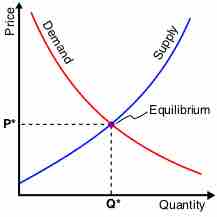In economics, a market is defined as a system or institution whereby parties engage in exchange. A market economy is an economy in which decisions regarding investment, production, and distribution are based on supply and demand, and prices of goods and services are determined in a free price system. The major defining characteristic of a market economy is that decisions on investment and the allocation of producer goods are mainly made through markets. This is the opposite of a planned economy, where investment and production decisions are embodied in a plan of production.
A free market is a market structure that is not controlled by a designated authority. Free markets may have different structures: perfect competition, oligopolies, monopolistic competition, and monopolies are all types of markets that may exist in a capitalist economy. The most basic models in economics assume that markets are free and experience perfect competition - there are many buyers and sellers so no individual actor may affect a good's price; there are no barriers to exit or entry; products are homogeneous; and all actors in the economy have perfect information.
Market Equilibrium
In a free market, the price and quantity of an item is determined by the supply and demand for that item. The market demand function describes the amount of a good that all consumers will purchase at a given price, while the market supply function expresses the amount that producers will supply at a given price. Consider the market for computers. At a price of $1,200, the market may demand 8,000 computers, while producers are willing to supply 15,000 computers. This is not the equilibrium price because at $1,200, supply exceeds demand. In order to reach equilibrium, the price must drop, causing demand to rise and supply to fall until the two are equal. This can be expressed graphically by drawing the market supply function and the market demand function and finding the point where the two curves intersect .

Market Supply and Demand
The market equilibrium exists where the market demand curve and the market supply curve intersect.
Changes to the market supply and market demand will cause changes in the equilibrium price and quantity of the good produced. For example, if a new technology is invented that allows producers to manufacture cars more efficiently, supply will rise and the market supply curve will shift to the right. The new market equilibrium will have a higher number of cars sold at a lower price. When markets are perfectly competitive, the equilibrium outcome of trade in the market is economically efficient. This means that the market is producing the largest net gain possible for society, given consumers' utility functions and producers' production functions.